|
Happily, quality has improved, and this ruby dark
garnet blend is an excellent example of how far they’ve come. It gives
up straightforward spicy plum and berry on the nose, more black than
red, and flavors echo with some subtle earth underneath, good
concentration, smooth texture, a decent finish and enough structure for
short term cellaring. Still, it drinks fine right now, and it makes a
great match for a wide variety of red-friendly foods, so what’s not to
like? Sees 10 months in both cement vats and large oak barrels, then
fined, filtered and bottled.
2005 La Vieille Ferme Côtes du Luberon Blanc,
30% Grenache Blanc, 30% Bourboulenc, 30% Ugni Blanc, 10% Roussanne,
$7.99, 12.5% alc.: Medium straw, shading to pale gold in color, with
flavors and aromas of yellow apple and melon, underscored with some
earthy mineral; soft and immediately accessible, yet showing good acids
and some of the heft that you get from blends of this kind, it makes a
good match for hors d’ oeuvres, seafood and chicken. We enjoyed it
with Black Forest ham and Gruyère paninis garnished with sliced onions
and Maille Dijon Mustard, along with a side bowl of chicken soup. 10% of
the Grenache Blanc is fermented in small, new, Limousin oak barrels, the
remainder in cement vats, then fined, filtered and bottled. Find this wine
2005 La Vieille Ferme Côtes du Ventoux Rosé, 50% Cinsault, 40%
Grenache, 10% Syrah, $7.99, 13% alc.: A pretty raspberry pink in
color, with unassuming watermelon, strawberry and rainwater flavors and
aromas, with a subtle minerality underneath; it shows good presence,
with enough acidity to work well with a variety of food options (we
liked it with salmon patties, tofu in a spicy Thai brown sauce and a
sautéed vegetable mélange). This is a good, honest everyday rosé that
will perform yeomen’s service any time of the year. Hand picked, lightly
crushed and put in stainless steel, with skin-juice contact for a day
and a night; then the free run juice is fermented in stainless steel at
70 degrees F. Find this wine
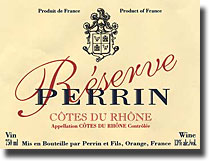 2004
Perrin Reservé Côtes du Rhône Rouge, 60% Grenache, 20% Syrah, 20%
Mourvedre, $10.99, 13% alc.: Made from fruit sourced from Perrin’s
vineyards at Grand Prebois and Vinsobres, as well as from
leased vineyards and purchased grapes and wines, this inky purple garnet
offers sweet spice, black plum and mulberry on the nose, but turns
decidedly drier on the palate, with fairly rich, earthy flavors
reminiscent of black plum and black currant. Almost claret-like in
character, with good depth and structure, and a smooth texture, this is
good stuff, well worth the price and it opens nicely with air, as is the
case with so many red Rhônes. It matches well with all the usual grilled
red meat suspects, and provides a nice pairing with a ground turkey
meatloaf with roasted red pepper sauce too! Fermented and matured mainly
in tank, with 25% in casks, then fined with egg whites and bottled. Find this wine 2004
Perrin Reservé Côtes du Rhône Rouge, 60% Grenache, 20% Syrah, 20%
Mourvedre, $10.99, 13% alc.: Made from fruit sourced from Perrin’s
vineyards at Grand Prebois and Vinsobres, as well as from
leased vineyards and purchased grapes and wines, this inky purple garnet
offers sweet spice, black plum and mulberry on the nose, but turns
decidedly drier on the palate, with fairly rich, earthy flavors
reminiscent of black plum and black currant. Almost claret-like in
character, with good depth and structure, and a smooth texture, this is
good stuff, well worth the price and it opens nicely with air, as is the
case with so many red Rhônes. It matches well with all the usual grilled
red meat suspects, and provides a nice pairing with a ground turkey
meatloaf with roasted red pepper sauce too! Fermented and matured mainly
in tank, with 25% in casks, then fined with egg whites and bottled. Find this wine
2005 Perrin Reservé Côtes du Rhône Blanc, 50% Grenache Blanc, 20%
Viognier, 15% Marsanne, 15% Roussanne, $10.99, 13% alc.: Medium
straw in color, with a lemon-like tinge, featuring a pear and melon
character with a hint of lemon and some subtle minerality; medium full
bodied, with moderate acids and medium length. Tasted side by side with
the La Vieille Ferme Blanc, this one shows a little more heft and
substance, and it also complements the Black Forest ham and Gruyère
paninis and chicken soup. A fine choice for an every day white,
fermented and matured in stainless steel tanks. Find this wine
2004 Perrin & Fils Côtes du Rhône Villages, 50% Syrah, 50% Grenache,
$14.99, 13% alc.: The only one of these wines that shows something
of the international style, this looks like ink in the glass, and it
smells something like chocolate covered cherries. It gives more
impressions of chocolate covered cherries in the mouth, anchored by a
solid, earthy core of black plums, currants and berries, all smoothly
textured, yet well structured, with earthy tannins that clamp down some
on the finish. Good now with some air and grilled flank steak, and even
better in three to five years, it’s not exactly traditional, but in this
case, that’s not a bad thing. De-stemmed whole berries heated to 176
degrees F, then cooled to 68 degrees F; macerated in concrete vats, then
matured in large oak vats (25%) and concrete tanks, and bottled after
egg white fining. Find this wine
2004 Perrin & Fils Côtes du Rhône Villages Vinsobres Les Cornuds, 50%
Syrah, 50% Grenache, $18.99, 14% alc.: Dark garnet, fading to pink
at the rim, with a generous nose of rich, ripe and earthy black plums
and berries that follows through on the palate with plenty more earth
and formidable structure; a leathery note emerges more and more with
air, helping to shape the character of the wine. If you must drink this
now, give it at least an hour in a decanter and grill some good red meat
to go with it, but really, five to eight years in the cellar would do
this one justice, and it’ll be a much better wine for it. Grapes
de-stemmed, with Syrah macerated in truncated tapered wooden vats with
cap punching and pumping over, and Grenache in stainless steel tanks,
then blended after malolactic fermentation. Matured in stainless steel
(80%) and two year old barrels, with six months bottle aging before
release. Find this wine
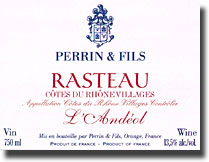 2004
Perrin & Fils Côtes du Rhône Villages Rasteau L’Andeol, 80% Grenache,
20% Syrah, $18.99, 14% alc.: Dark garnet in color from rim to rim,
with solid, straightforward flavors and aromas of black plums, currants
and berries, anchored with an earthy core and shaded with notes of briar
bramble and a certain meaty quality; it seems to show a hint of the 10%
cask maturation on the nose, but not in the mouth. Full bodied, dense,
well structured and yet accessible as it smoothes out with some time in
the glass, it will age and improve over the next three to five years, or
you can decant it for an hour now and enjoy it with grilled red meats or
a hearty stew. 2004
Perrin & Fils Côtes du Rhône Villages Rasteau L’Andeol, 80% Grenache,
20% Syrah, $18.99, 14% alc.: Dark garnet in color from rim to rim,
with solid, straightforward flavors and aromas of black plums, currants
and berries, anchored with an earthy core and shaded with notes of briar
bramble and a certain meaty quality; it seems to show a hint of the 10%
cask maturation on the nose, but not in the mouth. Full bodied, dense,
well structured and yet accessible as it smoothes out with some time in
the glass, it will age and improve over the next three to five years, or
you can decant it for an hour now and enjoy it with grilled red meats or
a hearty stew.
Find this wine
2004 Perrin & Fils Gigondas La Gille, 80% Grenache, 20% Syrah,
$26.99, 14% alc.: We’re suckers for good Gigondas at our house, and
this dark garnet gives further testimony as to why; it’s all underbrush
and earthy, leathery black fruit aromatics shaded with a note of tar,
with plenty more of all of the above in the mouth, fleshing out with an
hour’s air to morph into a pretty nice glass of wine. Full bodied, well
structured and reasonably long on the finish, with more and more leather
as it opens; indeed a few hours does wonders for this, but still, it’s a
ten year wine, so its best days are well ahead of it. Like the last few
noted here, give it some air if you have to drink it now, and pair it
with the usual suspects; otherwise, try it again in 2009 to see where
it’s at. Not de-stemmed, with vatting for 13 days and pumping over
rather than cap-punching; sees one year in casks (70%) and one year old
barrels. Find this wine
2003 Perrin & Fils Châteauneuf du Pape Les Sinards, 70% Grenache, 15%
Syrah, 15% Mourvedre, $34, 14% alc.: We weren’t wild about the
’98 Les Sinards, the only other one of these that we’ve tried
(not that it was a bad wine by any means), and while this one is not a
top flight CdP (nor was it meant to be), it is a solid effort for what
it is, especially considering the freak vintage. Dark garnet from rim to
rim, showing black plums and red berries on the nose, then turning
darker on the palate with earthy black plums and berries shaded with a
note of underbrush, a smidgeon of smoke and hints of cola, dusty cocoa
and lavender, with good structure and length and solid promise for
further development down the road. Not as smoky or spicy as many a
Châteauneuf, but it has other charms to compensate, as it opens and
evolves continuously over three hours, showing a real “sense of place.” Find this wine
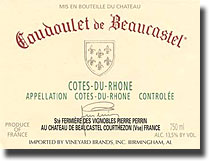 Coudoulet
de Beaucastel, the second wines of Chateau de Beaucastel, are
produced organically from vines that average 30 years of age, in
vineyards east of Route National No. 7, which divides the Côtes du Rhône
and Châteauneuf du Pape appellations at Beaucastel. These vineyards are
geologically identical to those of Beaucastel, with “a layer of marine
limestone-clay of the Miocene period, covered by an Alpine deposit of
smooth stones, or ‘galets,’ washed down by the Rhone River eons ago.”
The galets trap and retain heat, while preventing evaporation of
moisture from the soil. Coudoulet
de Beaucastel, the second wines of Chateau de Beaucastel, are
produced organically from vines that average 30 years of age, in
vineyards east of Route National No. 7, which divides the Côtes du Rhône
and Châteauneuf du Pape appellations at Beaucastel. These vineyards are
geologically identical to those of Beaucastel, with “a layer of marine
limestone-clay of the Miocene period, covered by an Alpine deposit of
smooth stones, or ‘galets,’ washed down by the Rhone River eons ago.”
The galets trap and retain heat, while preventing evaporation of
moisture from the soil.
2004 Coudoulet de Beaucastel Côtes du Rhône Blanc, 30% Marsanne, 30%
Viognier, 20% Bourboulenc, 20% Clairette, $39.99, 13.5% alc.: Medium
straw to pale gold in color, with a stingy nose that only hints at the
dry apple, peach and pear flavors underscored with restrained earth and
mineral and the barest hint of honey. Medium full bodied, with zippy
acidity and good length, showing some serious intensity, especially as
it opens with air; you could probably give it a good chill and then
decant it half an hour before drinking. This shows obvious aging
potential, and while I was initially dubious of the $40 SRP, I became a
believer as it continued to open and evolve, and it makes a fine match
for some highly seasoned broiled haddock, polenta cakes, homegrown
sautéed zucchini and onions and an arugula salad with a fig and onion
vinaigrette. I’d like to give this a try in another three to five years
to see how it evolves in the bottle. Hand-picked, sorted grapes are
pressed pneumatically, clarified and fermented in oak and stainless
steel, depending on varietal, then aged in oak and stainless steel for
eight months, blended and bottled without cold stabilization. Find this wine
2003 Coudoulet de Beaucastel Côtes du Rhône Rouge, 30% Grenache, 30%
Mourvedre, 20% Syrah, 20% Cinsault, $31, 13.5% alc.: Dark garnet in
color, fading to pink at the rim, and, much like
the ’98 version we enjoyed a few years ago, showing almost no
nose at first, and only a little more later, reflecting the flavors with
a hint of the barnyard; on the palate, it offers nice leathery black
plums and currants with an earthy base, and notes of cola, licorice and
briar bramble. Full bodied, smooth textured and well structured, with
good length, this one really benefits from some extended air, as the
fruit turns richer and sweeter, continually evolving, with almost every
sip showing something different, but while it’s perfectly enjoyable now,
its best days are clearly ahead of it, and it should easily improve
through 2013 and beyond. We didn’t have this one with food, but it drank
well while viewing a pre-season Detroit Red wings game; now, if it would
only do a Pinocchio and grow a nose. Hand picked and sorted, then
de-stemmed and “flashheated in a vinification technique invented by the
late Jacques Perrin,” aiding in the transference of aromas and color
to the wine and eliminating the need for the use of sulfur dioxide;
cooled, then macerated for 12 days in traditional tile lined vats, then
aged in large oak barrels for six to eight months, followed by light
fining with egg whites and bottling. Find this wine
Final thoughts: This lineup ranges from good to very good to excellent in
quality, and we quite enjoyed tasting through them all. They
mostly impress us as being “real wine,” rather than the kind of manufactured stuff
that is being produced more and more all over the world, although the
basic Côtes du Rhône Villages does seem to flirt with the "international
style." Still, they all do exactly what they’re supposed to do, and they
do it well. Having already been acquainted with La Vieille Ferme,
Perrin Reservé and Coudoulet de Beaucastel Rouge, I was particularly
interested in seeing how the others performed, and wasn’t disappointed
in the least. The Perrin family continues to carry on their great winemaking
tradition in grand style, and I’d recommend any of these wines without
hesitation.
Reporting from Day-twah,
Bastardo

Other Recent Wine Explorations
Harvest Images from Berthet-Rayne
Wicked Couch & Spit
September 2006 Bastardo's Best Buys
(Or Wines That Don't Suck)
Not Just Flotsam and Jetsam
More Wines With Friends
Wines of
Domaine Berthet-Rayne
Back to October '06 Index
Back to the Underground
Index
Back to the Top


© George Heritier October, 2006
|


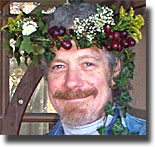
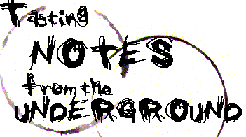

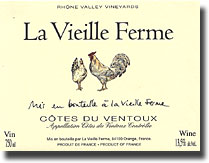


 Coudoulet
de Beaucastel, the second wines of Chateau de Beaucastel, are
produced organically from vines that average 30 years of age, in
vineyards east of Route National No. 7, which divides the Côtes du Rhône
and Châteauneuf du Pape appellations at Beaucastel. These vineyards are
geologically identical to those of Beaucastel, with “a layer of marine
limestone-clay of the Miocene period, covered by an Alpine deposit of
smooth stones, or ‘galets,’ washed down by the Rhone River eons ago.”
The galets trap and retain heat, while preventing evaporation of
moisture from the soil.
Coudoulet
de Beaucastel, the second wines of Chateau de Beaucastel, are
produced organically from vines that average 30 years of age, in
vineyards east of Route National No. 7, which divides the Côtes du Rhône
and Châteauneuf du Pape appellations at Beaucastel. These vineyards are
geologically identical to those of Beaucastel, with “a layer of marine
limestone-clay of the Miocene period, covered by an Alpine deposit of
smooth stones, or ‘galets,’ washed down by the Rhone River eons ago.”
The galets trap and retain heat, while preventing evaporation of
moisture from the soil.